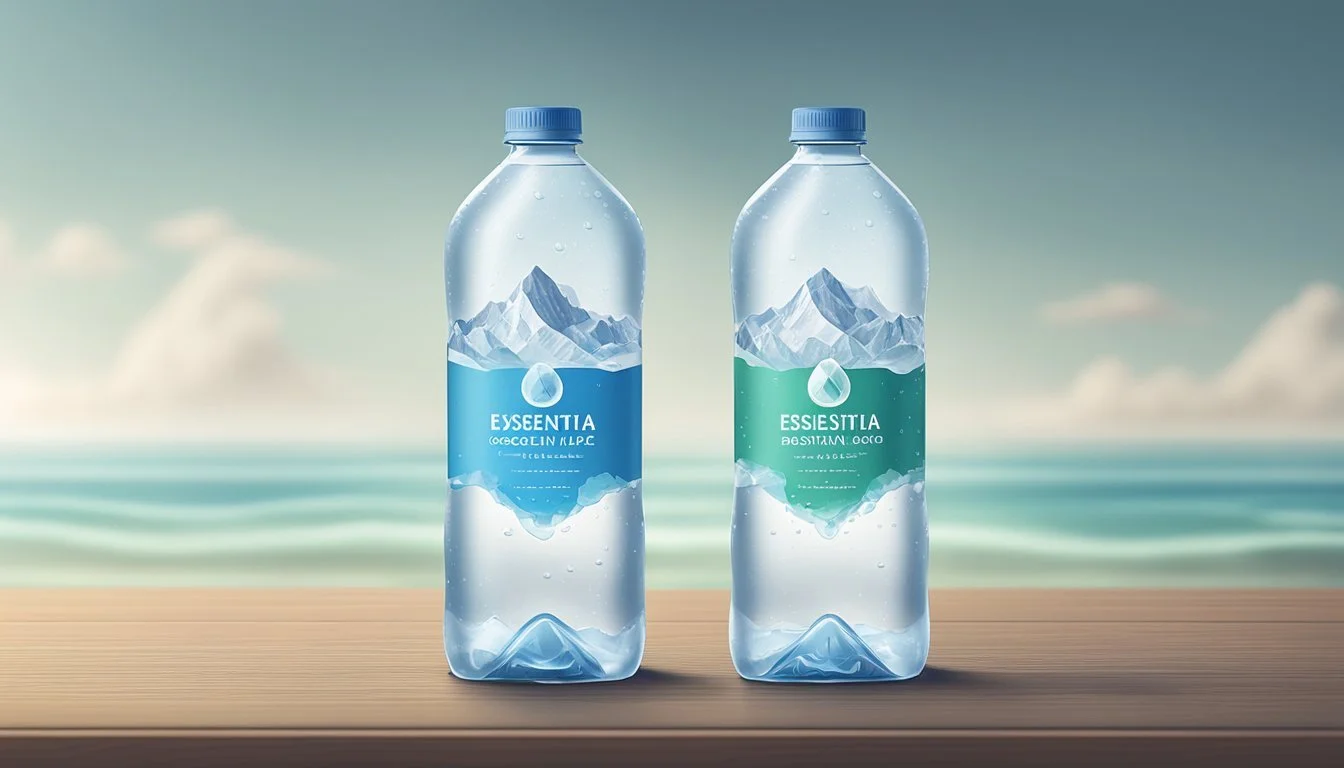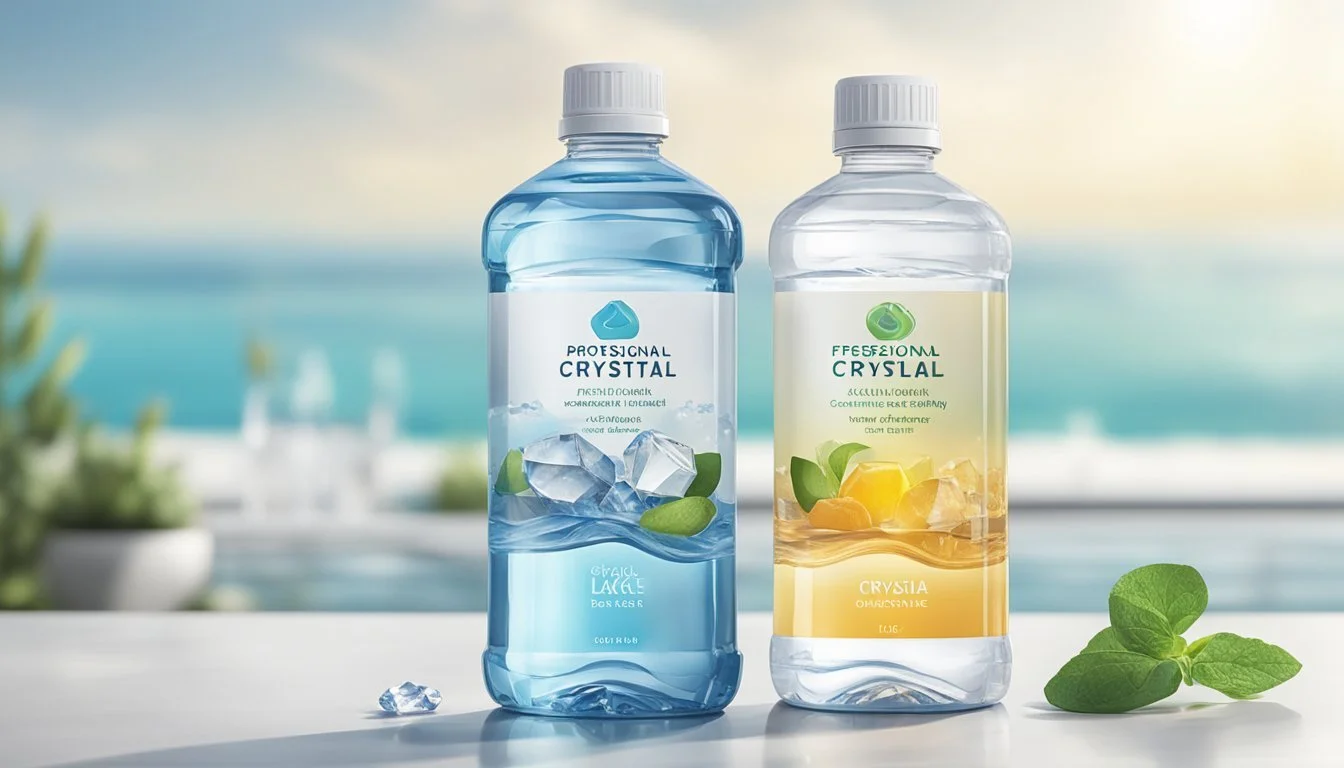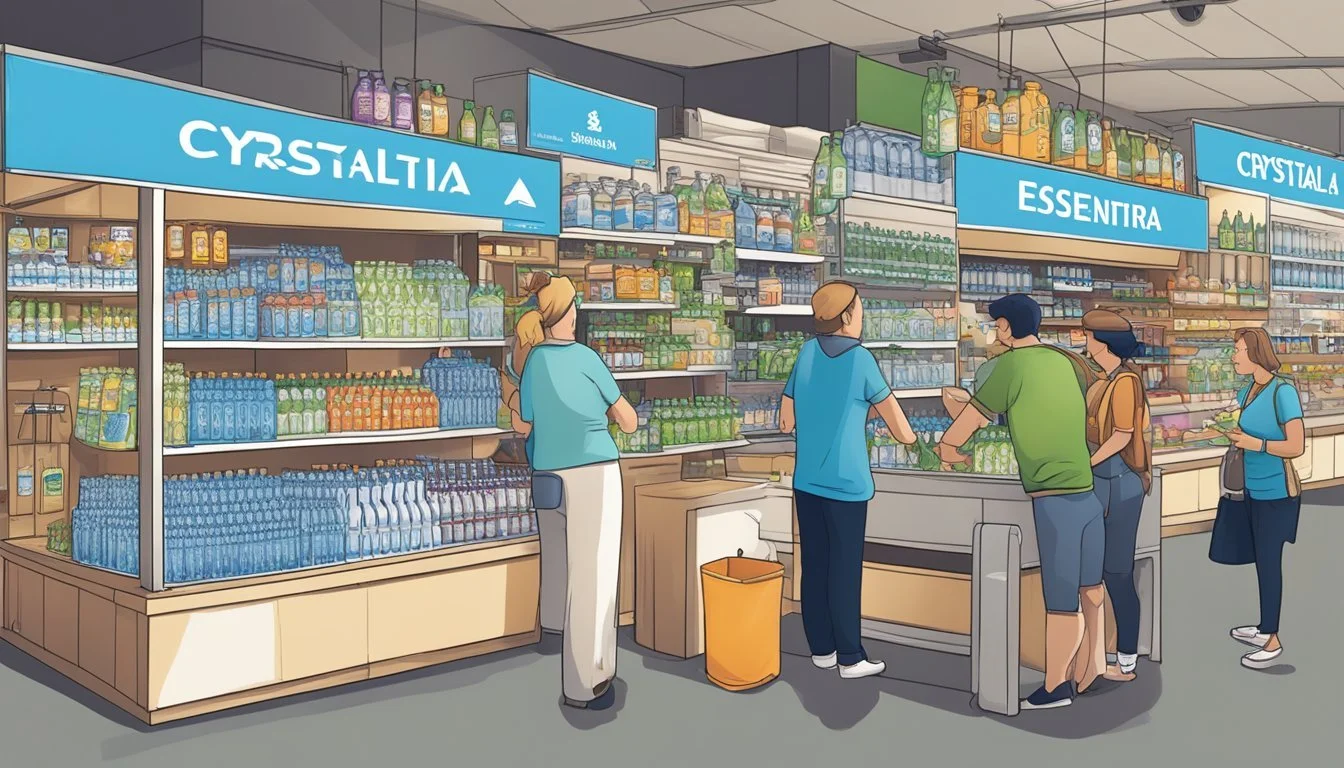Essentia vs. Crystal Lake
Comparing the Best Bottled Water Brands
When choosing between Essentia and Crystal Lake bottled water, there are several factors to consider, such as purity, taste, and customer satisfaction. For those seeking alkaline water with high purity, Essentia stands out with its rigorous filtration process and a pH of 9.5. This balance makes it a favorite among consumers looking for a refreshing and clean-tasting hydration option.
Crystal Lake, while also providing quality bottled water, appeals to those who prefer traditional spring water. Sourced from natural springs, it offers a crisp and clear taste without the added electrolytes found in Essentia. This can be a significant selling point for individuals who appreciate water in its natural state.
In direct comparison, Essentia appeals to health enthusiasts focused on hydration with benefits beyond just quenching thirst, thanks to its electrolyte-infused, alkaline nature. Crystal Lake caters to purists who favor spring water for its simplicity and direct source. By understanding the distinct features of each brand, consumers can make an informed choice tailored to their personal hydration needs.
Understanding Bottled Water
Bottled water comes in various categories and follows strict regulation and safety standards. These measures ensure that the water is safe for consumption and meets health guidelines.
Categories of Bottled Water
Spring Water: Collected from natural springs, this type is rich in minerals and often sought for its purity.
Purified Water: Undergoes processes like reverse osmosis or distillation to remove impurities. This category includes distilled and deionized water.
Mineral Water: Contains naturally occurring minerals, offering potential health benefits. The mineral content must remain constant without added minerals.
Sparkling Water: Naturally carbonated or artificially infused with carbon dioxide. It’s popular for those who prefer a fizzy drink.
Artesian Water: Sourced from confined aquifers. Known for its naturally filtered qualities.
Alkaline Water: Treated to increase its pH level, often marketed for its potential health benefits.
Regulation and Safety Standards
FDA Regulations: The FDA oversees bottled water safety in the U.S. It mandates that bottled water meets the same standards as municipal tap water.
Labeling Requirements: Bottled water labels must include the source and type of water, any added ingredients, and nutritional information.
EPA Standards: The EPA sets guidelines for tap water. While these do not directly apply to bottled water, many bottled water companies voluntarily meet or exceed these standards.
Health and Safety: Regular testing for contaminants like bacteria, chemicals, and heavy metals is compulsory. Bottled water facilities must follow good manufacturing practices.
Innovation and Safety: Modern filtration techniques and advanced packaging are used to maintain purity and safety. Bottled water must be stored and transported properly to avoid contamination.
Brand Profiles
Essentia and Crystal Lake are prominent bottled water brands with distinct characteristics and histories, which can help consumers make informed choices.
Essentia Water Overview
Essentia Water is renowned for its high pH level and advanced purification process. The water undergoes micro-filtration, reverse osmosis, and ultraviolet exposure, ensuring 99.9% purity. This rigorous process is followed by the infusion of electrolytes and ionization, resulting in alkaline water with a pH of 9.5 or higher.
Company Origins: Essentia was founded in 1998, with a mission to improve people's lives through better hydration. Their water is sourced from a variety of locations then processed to ensure consistency in quality and taste.
Brand Mission: Essentia aims to provide high-quality, effective hydration and frequently emphasizes its scientifically-backed process. The brand prides itself on transparency, making it clear what is in their water and how it is processed.
Crystal Lake Water Overview
Crystal Lake Water offers a more traditional approach to bottled water, focusing on purity and a clean taste. Sourced from natural springs, the water retains its natural mineral content, which contributes to its refreshing taste.
Company History: Crystal Lake was established in the early 2000s and quickly built a reputation for providing high-quality spring water. The company emphasizes sustainable practices and preserving the natural environment from which its water is sourced.
Brand Mission: Crystal Lake's mission revolves around sustainability and purity. They aim to deliver pure, refreshing water while maintaining eco-friendly practices. The brand highlights its commitment to conservation and reducing environmental footprints throughout their operations.
Water Source and Production Process
Essentia and Crystal Lake derive their bottled water from distinct sources and employ rigorous purification methods to ensure quality and taste, catering to hydration-conscious consumers.
Sourcing of Water
Essentia sources its water from a combination of local municipal water supplies. This ensures a consistent base that undergoes significant processing to achieve its final form.
Crystal Lake prides itself on sourcing from natural springs and protected aquifers. These sources are naturally replenished, providing a consistent and clean starting point for the bottled water.
The origin of the water is crucial, as it influences the initial purity and mineral content before any treatment processes are applied.
Purification and Enhancement Processes
Essentia water undergoes a multi-step process including micro-filtration, reverse osmosis, and ultraviolet exposure. These steps remove 99.9% of impurities, ensuring high purity levels. Following purification, Essentia water is infused with electrolytes and ionized to achieve a high alkaline pH of 9.5 or higher.
Crystal Lake emphasizes a natural filtration approach, utilizing minimal processing to preserve the water's natural mineral content. After sourcing, the water is subjected to basic filtration and disinfection to ensure safety without significantly altering its natural state.
By using more traditional purification methods, Crystal Lake maintains the natural taste and health benefits associated with spring and aquifer-sourced water.
Chemical Composition and Health Benefits
Essentia and Crystal Lake both have distinct chemical compositions that can impact the drinker's health and hydration levels. This section explores the differences in their mineral content, pH levels, hydration effects, and health implications.
Mineral Content and pH Levels
Essentia boasts a higher pH level of around 9.5, categorizing it as alkaline water. This is due to its proprietary ionization process. The mineral content in Essentia includes electrolytes like potassium, calcium, and magnesium.
Crystal Lake water, in comparison, has a neutral pH closer to 7.0. The mineral content here focuses on natural minerals that give it a refreshing taste. Both waters undergo thorough purification processes to ensure safety and quality.
Effects on Hydration
Alkaline water like Essentia claims to enhance hydration more effectively. The high pH level is said to help neutralize acid in the bloodstream, possibly reducing fatigue and improving metabolism. The electrolytes in Essentia also support hydration, crucial for physical performance and energy levels.
Crystal Lake, with its natural mineral content, offers hydration without altering the body's pH balance. It provides a balanced approach to hydration, making it suitable for daily consumption without the specific claims associated with high-alkaline water.
Health Implications
Essentia's higher pH level and added minerals may offer various health benefits, such as improved acid-base balance and detoxification. People who seek alkaline water might prefer Essentia for its potential to support better hydration and overall wellness.
Crystal Lake, with a more neutral pH, carries fewer claims about health benefits but is still a safe and effective hydration option. Its natural mineral content contributes to overall refreshment without potential side effects such as stomach discomfort that some may experience with high-alkaline water.
These factors make both Essentia and Crystal Lake viable options, depending on individual needs and preferences.
Taste and Texture
The taste and texture are crucial factors when comparing Essentia and Crystal Lake bottled water. These elements significantly influence consumer preference.
Evaluating Taste Profiles
Essentia Water is known for its neutral and clean taste. The meticulous purification process it undergoes removes almost all impurities, leading to a crisp and clear flavor that appeals to many. With its high pH of 9.5 or higher, it provides a slightly alkaline taste that some may find appealing and others may find barely noticeable.
Crystal Lake Water typically offers a balanced and pure taste derived from natural spring sources. The natural minerals in Crystal Lake water contribute to a refreshing flavor that doesn't overpower the senses. This water is often noted for its lack of aftertaste, making it a popular choice for those who prefer a straightforward and unembellished drinking experience.
Texture and Mouthfeel
Essentia Water has a smooth and almost velvety mouthfeel. The added electrolytes not only enhance hydration but also contribute to a fuller texture. This can make the water feel more substantial on the palate, which some consumers might find more satisfying. The ionization process ensures a consistent texture in every bottle.
Crystal Lake Water offers a lighter mouthfeel compared to Essentia, due to its natural origin and minimal processing. The texture can be described as crisp and invigorating. Its natural mineral composition provides a subtle, yet distinct smoothness that doesn't leave a residue and enhances the overall drinking experience without being overly thick or heavy.
Both brands provide unique experiences in taste and texture, catering to different preferences and hydration needs.
Environmental Impact and Packaging
Essentia and Crystal Lake vary significantly in their approach to packaging and environmental sustainability. This section explores the impact of their plastic bottles, the concerns associated with their use, and the sustainable practices they implement.
Bottles and Environmental Concerns
Essentia uses plastic bottles that are often made from polyethylene terephthalate (PET). This material is recyclable, yet the recycling rate remains low. Used plastic bottles can contribute to environmental pollution, taking hundreds of years to decompose.
BPA (bisphenol A), commonly found in some plastics, raises health concerns. Although PET bottles are typically BPA-free, the environmental impact of plastic waste is significant. Alternatives such as glass bottles or boxed water could reduce the ecological footprint, but these are not yet widely adopted by Essentia.
Crystal Lake also uses plastic bottles, but their practices in minimizing plastic waste are not widely publicized. Analyzing the energy consumption during production, it's evident that bottled water generates considerable CO2 emissions. For instance, producing 50 oz of bottled water releases between 1.6 and 22 oz of CO2, highlighting the environmental cost of plastic packaging.
Sustainable Practices and Alternatives
Essentia is making strides in sustainability. They focus on using recyclable materials for their bottles and have initiated programs to encourage recycling. However, their reliance on plastic remains a critical issue. Exploring boxed water or bottles made from plant-based materials could further enhance their sustainability efforts.
Crystal Lake's sustainable practices are less documented, making it challenging to evaluate their effectiveness. Promoting glass bottles or other eco-friendly packaging could improve their environmental impact. Engaging in initiatives to offset carbon emissions and reduce plastic use may also contribute positively.
Consumers seeking environmentally friendly options might consider the company's transparency and commitment to reducing plastic waste and CO2 emissions. Both brands can improve by adopting more sustainable packaging and reducing their reliance on traditional plastic bottles.
Market Presence and Consumer Choice
Essentia and Crystal Lake are both well-regarded brands, each with its unique market position, availability, and pricing strategies that influence consumer choices.
Availability and Convenience
Essentia Water, with its focus on premium alkaline water, is widely available across various channels. Consumers can find it in major grocery stores, health food stores, and on e-commerce platforms like Amazon. This extensive availability makes it convenient for consumers to purchase Essentia Water according to their shopping preferences.
Crystal Lake, known for its pure spring water, has a more regional distribution. While it is popular in specific areas, its availability in national chains and online marketplaces is more limited compared to Essentia. This limited distribution can influence the consumer's ability to consistently find and purchase Crystal Lake Water.
Cost Comparison
When it comes to cost, Essentia Water is positioned as a premium brand with higher pricing. A single bottle purchase from grocery stores or Amazon typically reflects this premium, often ranging from $1.50 to $2.00 per bottle. Bulk purchasing options are available that can lead to slight savings but still reflect its premium status.
Crystal Lake Water, with its regional focus, often is priced more competitively. The cost per bottle tends to be lower, making it an attractive option for price-sensitive consumers. In grocery stores, Crystal Lake can usually be found for $1.00 to $1.50 per bottle, providing an affordable hydration option without compromising on quality.
Comparative Analysis
Essentia and Crystal Lake are popular bottled water brands with unique features that appeal to hydration-conscious consumers. This comparative analysis provides insights into their benefits and criticisms.
Head-to-Head Comparisons
Essentia water is known for its high pH level, usually above 9.5, which makes it one of the most alkaline options available. It undergoes an ionization process and micro-filtration, resulting in 99.9% purity. Crystal Lake, on the other hand, offers a balanced pH closer to neutral, suitable for consumers who prefer less alkaline water.
In terms of purity, Essentia's multi-step filtration process contrasts with Crystal Lake's natural spring source, which may retain more natural minerals. Both have their loyal followers, with reviews indicating a preference for Essentia's crisp taste and Crystal Lake's natural flavor.
Standout Features
Essentia boasts a robust alkaline profile, with electrolytes added for enhanced taste and hydration benefits. The alkaline nature of Essentia is thought to aid in neutralizing body acidity and improving hydration efficiency. Its consistent high pH and purity levels are standout features noted by consumers in reviews.
Crystal Lake is prized for its natural origin and minimal processing. The brand emphasizes sourcing water from protected springs, which many consumers find appealing. The retention of natural minerals and the smooth, clean taste are highlighted as distinguishing factors when compared to more processed waters.
Shortcomings and Criticisms
Essentia's high pH and ionization process may not appeal to everyone. Some consumers prefer the taste of more naturally sourced water. The perception that processed water is less "natural" can be a deterrent.
Crystal Lake, while appreciated for its natural qualities, may lack the consistency in purity that Essentia offers. The natural mineral content can vary, and it might not always meet the preferences of consumers seeking highly purified, electrolyte-enhanced water.
Both brands have their strengths and weaknesses, with consumer reviews split based on personal taste preferences and health beliefs. Essentia often ranks higher in "best water" categories for its hydration properties, while Crystal Lake is favored for its authenticity and taste.
Concluding Thoughts
Both Essentia and Crystal Lake offer unique advantages for consumers, depending on personal preferences and specific needs.
Final Recommendations
For those valuing alkaline properties, Essentia stands out with its high pH level of 9.5, achieved through a detailed micro-filtration and ionization process. This makes it a robust choice for consumers focused on alkalinity and electrolytes.
Conversely, Crystal Lake appeals to those preferring natural spring water. Its purity and natural mineral content make it suitable for individuals who prioritize water sourced directly from nature without extensive processing.
Bottom line:
Choose Essentia for a high-pH, electrolyte-infused option.
Opt for Crystal Lake for a natural spring water experience.
Evaluating personal preferences is key to selecting between these two quality bottled water brands.
More About Essentia
Essentia vs Cascade Mountain: Which Bottled Water is Better?
Essentia vs Hawaiian Springs: Which Bottled Water is Better?
Essentia vs Icelandic Glacial: Which Bottled Water is Better?
Essentia vs Kirkland Signature: Which Bottled Water is Better?
Essentia vs Mountain Valley Spring Water: Which Bottled Water is Better?
Essentia vs Nestle Pure Life: Which Bottled Water is Better?
Essentia vs Richard's Rainwater: Which Bottled Water is Better?
Essentia vs Talking Rain AQA: Which Bottled Water is Better?
Essentia vs Whole Foods Italian Still Mineral water: Which Bottled Water is Better?
More About Crystal Lake
Aqua Carpatica vs Crystal Lake: Which Bottled Water is Better?
Cascade Mountain vs Crystal Lake: Which Bottled Water is Better?
Core Hydration vs Crystal Lake: Which Bottled Water is Better?
Crystal Geyser vs Crystal Lake: Which Bottled Water is Better?
Crystal Lake vs Essence pH10: Which Bottled Water is Better?
Crystal Lake vs Proud Source: Which Bottled Water is Better?
Hawaii Volcanic vs Crystal Lake: Which Bottled Water is Better?
Hawaiian Springs vs Crystal Lake: Which Bottled Water is Better?
Ice Mountain vs Crystal Lake: Which Bottled Water is Better?
Icelandic Glacial vs Crystal Lake: Which Bottled Water is Better?
Kirkland Signature vs Crystal Lake: Which Bottled Water is Better?
Liquid Death vs Crystal Lake: Which Bottled Water is Better?
Mountain Valley Spring Water vs Crystal Lake: Which Bottled Water is Better?
Nestle Pure Life vs Crystal Lake: Which Bottled Water is Better?
Poland Spring vs Crystal Lake: Which Bottled Water is Better?
Purely Sedona vs Crystal Lake: Which Bottled Water is Better?
Richard's Rainwater vs Crystal Lake: Which Bottled Water is Better?
San Pellegrino vs Crystal Lake: Which Bottled Water is Better?
Simple Truth vs Crystal Lake: Which Bottled Water is Better?
Solan de Cabras vs Crystal Lake: Which Bottled Water is Better?
Talking Rain AQA vs Crystal Lake: Which Bottled Water is Better?
Whole Foods 365 vs Crystal Lake: Which Bottled Water is Better?
Whole Foods Italian Still Mineral water vs Crystal Lake: Which Bottled Water is Better?








